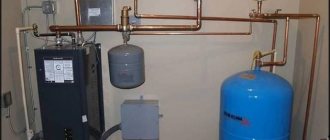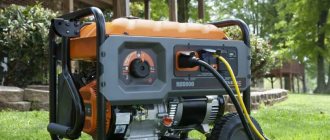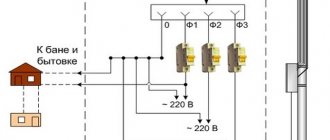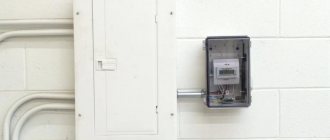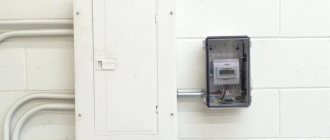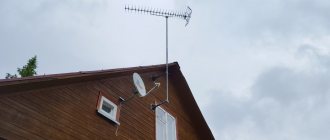It is recommended to carry out video surveillance for a private home in order to protect the territory of the site and the interior of the house from penetration by unauthorized persons and intruders. We will understand the preparatory stages of selecting equipment, types of video cameras and the main steps of self-installation of a video surveillance system.
Modern video surveillance can be integrated into a smart home system Source hikvision.biz.ua
Preparatory work for selecting the necessary equipment
With the help of video surveillance, you can recognize arriving guests, monitor children and elderly family members. This is a more economical option than concluding an agreement with a security company. Video surveillance systems operate around the clock and consume very little electricity. The equipment operates independently without the involvement of the human factor.
The composition of a video surveillance system is determined by the goals and tasks that it will perform. First, it’s worth understanding the question of how to choose a video surveillance system for a private home. Define tracking zones and other video monitoring functions:
- approaches to the land plot (along the entire perimeter of the fence or only the entrance elements);
Approximate layout of cameras in a private house Source nadzor.ua
- whether or not to include adjacent parts of the street;
- courtyard (entirely or separate buildings);
- the whole house around the perimeter or just windows and doors;
- the distance from which a person can be identified;
- Do you need video surveillance recording (during the day, night);
- transferring video recordings via the Internet to a smartphone, tablet, TV.
The same area can be viewed by several cameras. They must be selected before installation begins. If you set the task to control the entire territory, you need to take into account that this will be a rather expensive option. Before turning it into reality, such a need should be carefully thought out and justified.
Based on the selected zones and objects, a video surveillance kit is selected for a private cottage. Knowing the number of security cameras, choose their installation locations. To do this, you should use a map of the territory, mark the installation points of the devices on it and mark the areas covered by their control. Most often tracked:
- entrance area to the site;
- front door to the house;
Example of tracking zones in a private home Source trb.in.ua
- Garage Doors;
- entrances to all buildings on the site;
- parking and storage areas for expensive equipment.
To monitor the entire perimeter of the cottage, cameras are installed in the corners of the building. To view the entire area, one camera mounted on a high support is enough.
For tracking along the perimeter of the fence, cameras with a small viewing angle are used. They are placed on fairly high supports, while taking into account and eliminating obstacles blocking the observation zone.
To take pictures in the area of the front door of the house, front cameras with good resolution are installed. As an option, a peephole camera is suitable for the front door, and a video intercom for the entrance gate.
Camera installation locations are chosen taking into account the protection of vandals and natural phenomena: rain, hail, solar radiation, wind.
Price policy
The final cost of a complete set of equipment will depend on several factors. Firstly, a lot determines the type of system chosen. Secondly, the price is affected by the number of cameras or additional devices.
Don't forget that for an analog video camera to work properly, you need a good DVR. The more recording points, the more equipment required. The third factor influencing the final cost of the equipment is the place of purchase (country/city/type of store).
If a user needs 1 digital video camera (for example, for surveillance in the living room), the device will cost around 3-6 thousand rubles. Since the IP video control camera connects to the local network, no other equipment is required in this case.
You also need to take into account the fact that any equipment requires periodic maintenance. The cost of such services depends on the pricing policy of the selected company.
List of equipment for the video system
The installation kit for video surveillance in a private home must include the following functional elements:
- yard or indoor video cameras;
- device for recording footage (video recorder);
- HDD;
- power supply for cameras;
- cables for connecting the recorder and cameras;
- platforms for mounting cameras, connecting elements, sleeves and channels for pulling wires.
For greater reliability, the composition can be supplemented with an uninterruptible power supply (UPS), a monitor with a modem. The UPS will allow the video surveillance system to operate during a power outage. A modem with a monitor will ensure viewing of the recording in real time at a considerable distance.
When choosing a wired or wireless system, you need to know that wireless equipment is less reliable. Behind the visible advantages (ease of installation, absence of a web of wires) there are significant disadvantages (small coverage radius, sensitivity to atmospheric influences and nearby electrical equipment).
Types of video cameras
Cameras are divided depending on their installation location. Indoor video cameras are installed indoors. The latter can be heated or unheated. External devices are installed outdoors. This determines the different temperature ranges in which they can operate and the level of protection from climatic conditions. For cameras inside buildings, the temperature range starts at -15°C, the protection class is IP20 and higher. Outdoor cameras from IP66. External cameras are manufactured with a reinforced housing to protect against intentional damage.
Box video cameras Source video-security.by
According to the design of home video surveillance cameras, there are:
- case-based - the camera is located inside the housing, fixed to the installation site;
- cylindrical - the camera is hidden inside a cylindrical body, only the “pupil” of the lens looks out;
- dome - have the outline of a hemisphere, mounted on a flat plane, in particular on the ceiling of the room.
Cameras can be fixed in one position and monitor a certain area from one angle. All types of cameras can be rotating, with different rotation angles, in different planes, and with different tracking speeds. There are devices that follow the movement of the observed subject. If desired, you can install hidden video cameras that monitor a certain area within the range of the device.
To answer the question of which video surveillance camera to choose for your home: analogue or digital, you need to know their structure, operating principle, advantages and disadvantages.
Bullet IP video cameras Source revel.com.ua
See also: Catalog of companies that specialize in electrical work of any complexity
An analog camera is a device that is connected to a computer or TV to view images. The transmitted information is processed into digital form using a recorder. Modern analog cameras have a resolution of up to 2 megapixels and transmit color images. The signal is transmitted via coaxial cable. Its length cannot be more than 500 m; exceeding it leads to deterioration in image quality. Analog equipment is easy to install and configure.
The contrast and clarity of the image depends on the choice of an analogue or digital camera.
These characteristics are displayed for digital images by pixels, for pictures taken by an analog camera, by the TVL indicator (television vertical and horizontal lines).
In private homes, analogue cameras with TVL 600-800 are more often installed. This is enough to recognize faces at a distance of 10-15 meters from the device. To identify guests over long distances, video cameras with TVL 900 and higher will be needed, and the cost of the equipment will increase accordingly.
Dome cameras Source control.ua
The great popularity of analog devices is explained by their lower price due to their small viewing radii. Modern video cameras combine the properties of analog and digital devices and transmit signals in AND, TVi, CVi formats with a clearer picture. Analog-digital cameras are an economical option for a video surveillance system for a private home with good image quality.
If a home owner wants to connect cameras to external devices via the Internet, he will have to buy and install IP cameras. They work like a small computer with components in the form of a processor, RAM, built-in interface, and matrix. Requires software that is constantly updated. IP cameras encode the data received from the matrix into a digital signal and use it to transmit the image to a cloud server, recorder or computer.
A digital device may have a storage device, USB, Wi-Fi, motion and zoom control modules.
Principle of operation
A video surveillance system can include completely different types of equipment, but in general it works like this: a video camera reads data and sends it to the recorder for processing. The user can see the captured image on the screen. The camcorder can record data or display it in real time (without recording).
There are several types of video surveillance:
- Analog;
- Digital.
Video surveillance on an analogue system
Using an AV cable, the video camera is connected to the recorder, which is connected to the monitor. To connect such equipment directly to a PC, you will need to install an additional gadget, namely a video capture card.
The appearance of digital devices (IP video cameras) on the market led to a powerful displacement of analog systems, including analog television. Digital cameras have extensive functionality, which could not fail to attract the attention of progressive users who always want to keep up with the times. What is the main difference between digital and analogue systems? Described in more detail in another article - differences between analogue and digital CCTV cameras
For example, digital equipment is equipped with motion sensors and a sound recording function. It encrypts the signal and interacts well with any other modern equipment. Developers offer their clients many interesting and life-simplifying services with which IP devices integrate perfectly. Analog video surveillance cannot boast of similar options and advantages.
But this does not mean that analog video cameras have lost demand among buyers. Equipment of this type is an excellent alternative, and in some individual cases it is considered the best option for increasing the level of security in a protected area.
Video surveillance based on IP cameras
Installing a digital camera does not involve any particular difficulties, since the device only needs the Internet for full operation. Any user can cope with the task. In this case, a DVR is not required.
An IP camera can be connected to a local network in two ways: wired (via a special cable) and wireless (via a Wi-Fi router). To configure your device, you must assign it a unique IP address. This can be done in the router interface.
If the user wants to take the path of least resistance, he has the opportunity to connect the IP device to any convenient cloud service. With this option, you do not have to perform the steps described above.
What does an IP video surveillance camera consist of:
- Lens;
- Filter;
- Matrix CDD;
- Video data capture device;
- Image compression unit;
- Processor and IP server;
- RAM;
- Flash memory;
- Network connection interface;
- Information output port (audio and video);
- Signal inputs and outputs (alert sounds, etc.).
Installation of video cameras: where is it better?
Video monitoring devices are divided into two types: outdoor and indoor. Each user must independently determine the optimal location of the cameras around the perimeter of the protected facility, since in this matter everything is too individual. The most important thing is that the equipment fulfills its intended purpose – high-quality and clear monitoring of a specific location.
Digital video cameras are most often installed at sites such as private houses, apartments, businesses, warehouses, banks and shopping centers. The main advantage of digital video monitoring systems over analog devices is that the user can monitor what is happening in the protected area remotely. To do this, you only need access to the Internet, and nothing more.
If the user does not need detailed recording of data on a small protected object, it is more advisable to give preference to an analog system. The installation of such systems should be carried out by a specialist. Do-it-yourself installation is not considered here.
In addition, one very important point needs to be taken into account: it is better to spend more time finding the optimal installation location for the device with a good recording angle, since making any adjustments to such a system is extremely problematic. And for each innovation you will have to pay the master additionally.
Video description
Advantages of digital IP cameras over analog video surveillance
Advantages of digital IP cameras:
- high resolution up to 8 megapixels and the presence of a zoom function;
- recording option via a cloud service;
- wireless connection that allows you to view footage from anywhere.
Flaws:
- high price;
- incompatibility of cameras and recorders of different brands.
When the DVR is located at a considerable distance from the cameras, analog models with long cable lines are chosen. When cameras and recorders are located close together, IP devices take priority.
The criteria for choosing camera parameters depend on the distance and recognition level. To obtain a clearer, more detailed image at a greater distance, more advanced and expensive cameras will be required.
For observation only, without the requirement to distinguish faces, cameras with a wide viewing angle, a lens size of 1.8-3.6 mm, and a resolution of 1.2-1.5 megapixels are well suited.
For detail and greater clarity, a lens from 4 to 50 mm is required. The larger the lens size, the better the picture, but at the same time the coverage angle of the area narrows and more installed cameras are required.
Main characteristics of video cameras
It is very important to choose the right video cameras for the system, so when choosing, you need to pay attention to the following characteristics:
- Resolution options. The detail of the “picture” depends on them. For home cameras, high resolution is not necessary; it can be the same as regular webcams. For outdoor (street) surveillance, 1.0-2.0 megapixels (Mpx) will be sufficient. For high detail, for example, when recognition of human faces or car license plates is required, it is necessary to select devices with a resolution of 3.0-5.0 MPx.
- The parameter corresponding to the frame rate can be in the range of 8-30 FPS. If you need to track stationary objects, then the minimum FPS will be sufficient. For more dynamic tasks, 30 FPS may be needed. You need to be careful here, since often for marketing purposes the maximum frequency is indicated for a low resolution, for example, 640x480. In this case, FullHD will operate at a lower frequency. On the other hand, the task of security systems does not include shooting video, and low fps significantly relieves traffic.
- Availability and range of infrared illumination (if this is necessary, in some cases it will be cheaper to install a spotlight).
- Lens characteristics (viewing angle, focus, etc.) and the presence of zoom.
- Housing design (regular or anti-vandal).
Hiwatch dome camera in anti-vandal housing
Basic steps for self-installation of the system
Step 1. Cable routes
For a video surveillance device on your own, first of all you need to correctly lay out the cable routes. When using analog systems, a coaxial cable is laid, which does not require additional video converters. The shielded cable covering protects the video surveillance system from extraneous influences.
Digital IP systems use twisted pair cable. It consists of several pairs of conductors intertwined with each other. Due to this, the level of dependence on electromagnetic interference is reduced.
Video description
How to independently connect a video surveillance camera in a private house
The longest lines are laid first, then closer objects are connected. The cable requirement is calculated with a small margin.
Cable routes are installed in an open or hidden way. Open cable laying is carried out along the fence of the site or by hanging it on additional supports. Of particular importance is the insulation and length of air sections - no more than 50 meters.
Closed cable laying is carried out underground or in wall recesses. Corrugated hoses or metal-plastic pipes are used for cable laying. The standard distance for video surveillance lines from power lines is no closer than 0.4 meters. If it is impossible to comply with the standard, the video line is protected with a dielectric cable duct or a grounded metal casing.
Video description
How to assemble a set of video surveillance cameras with your own hands
To install video cameras in a private house, reliable fastenings are used to prevent vibration of the devices from the effects of wind.
Step 3. Installing the DVR and connecting cameras
It is preferable to purchase a DVR with the PoE (Power over Ethernet) option - it will provide power to the cameras without laying a separate power supply cable.
The main condition for the correct connection of cameras to the recorder: do not mix up the wires and connectors. The DVR is installed in a room with good ventilation to prevent overheating of the device. The power connection starts with the recording device, then the cameras are connected.
If there is no PoE device in the recorder, the connection rules are followed: plus to plus, minus to minus. All connections and connectors are protected from external influences by junction boxes.
Step 4. Hardware setup
The final stage of installing a video surveillance system for an individual home will be its configuration.
Installation and configuration of a video surveillance system Source znaj.ua
Video system adjustment algorithm:
- Displaying the date and time on each device, checking compliance with the time zone on the router.
- Formatting hard drives using the web interface, recorder and IVMS program.
- Setting up video cameras for optimal tilt and rotation angles to cover the maximum observation area.
- Setting up video recording in a DVR client program that ensures coordinated operation of a large number of cameras from one computer device.
- Debugging remote viewing of cameras from cloud services or searching in a browser by IP address.
It is important to know how to install video surveillance on your own the first time without making common mistakes. Preliminarily analyze them based on the experience accumulated in this area:
- inaccurate calculations due to incorrectly measured distances between the recorder and cameras, resulting in incorrect cable selection;
- selection of a power source of insufficient power;
- using a hard drive with a capacity inappropriate for the scale of information being transferred.
Debugging remote viewing of cameras from cloud services or searching in a browser by IP address Source harberthomesystems.com
What are CCTV systems?
This term refers to hardware and software systems that provide the ability to organize visual surveillance of a certain territory. In addition to video cameras, the hardware of the systems includes video recorders, video servers, monitors, etc. The software of the complex includes programs for processing and storing images, building a multi-level security system, organizing access to databases, etc.
An example of a simple system that allows you to organize observation from 4 points is presented below.
Fig 1. Simple video security scheme for a dacha
Designations:
- 1-4 Analog type surveillance cameras.
- A – Image output device (monitor or TV).
- B – 4-channel analog recorder.
In this simple system, four analog video cameras are connected to the DVR using a coaxial cable. The recorder outputs information to the monitor. In this case, it is possible to receive information from any of the cameras or display images from all sources at once.
Video monitoring is an important element of dacha security
The information posted in this article will tell you how to make video surveillance at your dacha. The rules and regulations for designing a video system in a private home are also applicable for a summer cottage, you just need to take into account certain installation nuances.
Video cameras in the country Source besplatka.ua
Dacha equipment must operate flawlessly at sub-zero temperatures, since dachas are not heated in winter. All elements of the system installed outdoors must function normally in all weather conditions. Equipment must be protected from intruders. You need to carefully consider how and where to install video cameras. It is better to disguise them, perhaps even by installing fake devices to disorient thieves and vandals.
The cameras will need to be equipped with motion sensors, infrared, and night vision. All video surveillance areas should be additionally illuminated.
Remote video surveillance for a dacha Source svs.kh.ua
Install the DVR in a hard-to-reach secret place. The most convenient way to work with a country video system is through a “cloud” service: it allows you to see the image on a PC or phone. The communication scheme is as follows: camera - DVD - router - host. The image from the camera goes to the “cloud”, which provides remote communication and the ability to monitor the dacha area in real time.
The owner of a private house or summer cottage is obliged to warn possible visitors about conducting covert surveillance. This is established by current legislation. Special illuminated warning signs are sold.
For trouble-free operation of a video surveillance system, it is necessary not only to install and configure it correctly, but also to regularly carry out maintenance and repairs.
Restrictions
When installing visual surveillance, legal regulations should be taken into account. In the Russian Federation this is Article 138.1 of the Criminal Code. We will not present it in full; its essence can be briefly presented as follows:
- Surveillance systems can be installed anywhere on your territory, provided that the cameras do not record other people’s property.
- If video surveillance is carried out in any public place, store, office, entrance, on the street, etc., then it is necessary to notify about it. To do this, a corresponding notice is installed in a visible place (usually at the entrance to a building or premises).
- The installation of visual surveillance devices in private premises (toilet, fitting room, shower, etc.) is prohibited.
Briefly and about the main thing
With the help of video surveillance, you can recognize arriving guests, monitor children and elderly family members. This is a more economical option than concluding an agreement with a security organization.
To monitor the entire perimeter of the cottage, cameras are installed in the corners of the building. To view the entire area, one camera mounted on a high support is enough.
If there is no lighting in the surveillance area, cameras with infrared illumination are chosen. They have a tracking range of 30 meters.
For a video surveillance device on your own, first of all you need to correctly lay out the cable routes. If self-confidence is not enough, it is better to seek help from professionals.


